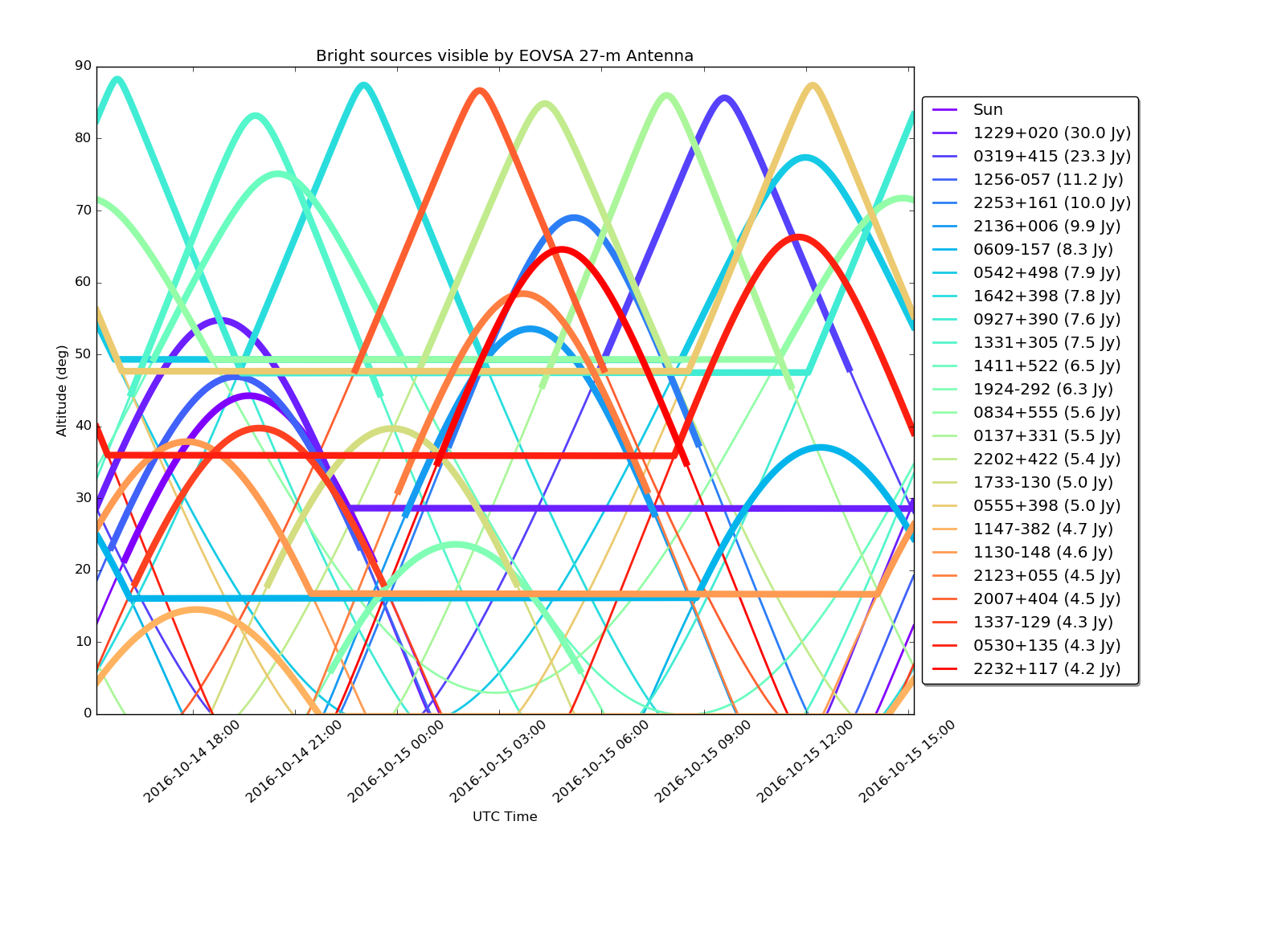Calibrator Survey: Difference between revisions
(Created page with "The purpose is to do a survey of calibrators listed in the [http://www.aoc.nrao.edu/~gtaylor/csource.html VLA Calibrator Manual] in the EOVSA frequency range (2.5-18 GHz) to d...") |
No edit summary |
||
| Line 2: | Line 2: | ||
==Observing Sequence== | ==Observing Sequence== | ||
Bin wrote a routine named "eovsa_src_visibility.py" on helios. Dale upgraded it with more user-friendly features named "dg_src_visibility.py". They display the visibility of all VLA calibrators by the 27-m antenna above a certain flux density threshold (defined by parameter "minflux") in C band for a given time and duration. An example of this plot is shown in Fig. 1: | Bin wrote a routine named "eovsa_src_visibility.py" on helios. Dale upgraded it with more user-friendly features named "dg_src_visibility.py". They display the visibility of all VLA calibrators by the 27-m antenna above a certain flux density threshold (defined by parameter "minflux") in C band for a given time and duration. An example of this plot is shown in '''Fig. 1'''. From this plot, the observer is asked to create the observing schedule that covers as many calibrator sources as possible, according to some criteria such as: -29d < DEC < 45d, Altitude > 10 deg, and at least 10 ~ 20 deg away from the Sun (etc.?). The observer is advised to include at least one? coverage of the sources 3c286 (1331+305) and 3c48 (0137+331) during the observing schedule. | ||
[[File:Cal src vis.png |thumb|upright=3.0| '''Fig. 1:''' The plot produced by dg_src_visibility.py for the time frame 2016-10-14 15:10 UT to 2016-10-15 15:10 UT, showing sources with minflux = 4.0 (Jy).]] | |||
Revision as of 20:26, 16 November 2016
The purpose is to do a survey of calibrators listed in the VLA Calibrator Manual in the EOVSA frequency range (2.5-18 GHz) to determine their spectral shapes. The results are very useful to determine whether or not a phase calibrator in question is suitable for the entire EOVSA bandwidth or is only usable for a fraction of the bandwidth. It is also valuable to test the sensitivity limit of EOVSA's 27-m + 2-m baseline within a reasonable amount of integration time (10 minutes). The best calibrator sources are those 1) bright enough over the entire band (within ~10 min of integration), and 2) show a rather flat visibility vs. UV distance curve (point source).
Observing Sequence
Bin wrote a routine named "eovsa_src_visibility.py" on helios. Dale upgraded it with more user-friendly features named "dg_src_visibility.py". They display the visibility of all VLA calibrators by the 27-m antenna above a certain flux density threshold (defined by parameter "minflux") in C band for a given time and duration. An example of this plot is shown in Fig. 1. From this plot, the observer is asked to create the observing schedule that covers as many calibrator sources as possible, according to some criteria such as: -29d < DEC < 45d, Altitude > 10 deg, and at least 10 ~ 20 deg away from the Sun (etc.?). The observer is advised to include at least one? coverage of the sources 3c286 (1331+305) and 3c48 (0137+331) during the observing schedule.
